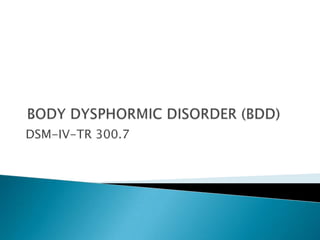
Body Dysmorphic Disorder (BDD) Diagnosis and Treatment
- 1. BODY DYSPHORMIC DISORDER (BDD) DSM-IV-TR 300.7
- 2. The defect is either imagined or if a physical anomaly is present individuals exhibit excessive concern Preoccupation must cause significant distress or impairment in social, occupational, or other areas of functioning The preoccupation is not better accounted for by other mental D/O (e.g. body shape in Anorexia Nervosa WHAT IS BDD?
- 3. Thinning hair Acne Wrinkles Scars Vascular Markings Pale or Red complexion Swelling Facial disproportion Shape or size of: Nose Eyes Eyebrows Ears Mouth Lips Teeth Jaw Cheeks/Chin Size of muscles COMPLAINTS INVOLVE IMAGINED OR SLIGHT FLAWS OF THE FACE OR HEAD:
- 4. The genitals, buttocks, abdomen, arms, hands, feet, hips, shoulders, or overall body size and shape. Preoccupation may focus on several body parts. Individuals will avoid describing defects because of embarrassment. They will only refer to their general ugliness. OTHER BODY PARTS MAY END UP THE FOCUS OF CONCERN:
- 5. INTENSLY PAINFUL, TORTURED, DEVASTATING http://www.youtube.com/watch?v=iAuc2xAM7-8
- 6. PREOCCUPATION, MAY BE NO EFFORT TO RESIST PREOCCUPATION, MAY BE AVOIDING SCHOOL, WORK, FAMILY, & ACTIVITIES
- 7. BDD IS OFTEN MISDIAGNOSED BECAUSE THE CLIENT MAY BE ASHAMED OF THEIR OBSESSIONS CO-MORBID WITH AXIS 1 DX OBSESSIVE COMPULSIVE D/O, SOCIAL PHOBIA, ANOREXIA NERVOSA, & SUBSTANCE ABUSE
- 8. BDD SHARES A CO-MORBIDITY WITH AXIS II DX MOST BDD CLIENTS HAVE CLUSTER C PERSONALITY D/O: AVOIDANT, PARANOID, OR OBSESSIVE COMPULSIVE PERSONALITY.
- 9. BDD MAY BEGIN IN CHILDHOOD, BUT USUALLY OCCURS IN ADOLESCENCE AND YOUNG ADULTS. Average age of onset is 16 – 17 years although ir may be seen in older adults who are concerned with aging. Affects 1-2% of the population Affects men and women almost equally No association between BDD and race BDD is a chronic lifelong condition. ETIOLOGY
- 10. WHAT CAUSES BDD?
- 11. CULTURES WITH HIGH EMPHASIS ON BEAUTY AND APPEARANCE PEOPLE FROM A HIGHER SOCIOECONOMIC STATUS OR HAVE STRICT CULTURAL STANDARDS MAY EXPERIENCE BDD MORE OFTEN THEY MAY HAVE EXPERIENCED A TRAUMATIC EVENT OR CONFLICT DURING CHILDHOOD. LOW SELF-ESTEEM HAVE PARENTS OR PEERS WHO ARE CRITICAL OF THEIR APPEARANCE. RISK FACTORS MAY INCLUDE:
- 12. AS WITH OTHER SOMATAFORM DISORDERS BDD MAY ALSO BE CAUSED BY THE NEUROTRANSMITTERS IN THE BRAIN. THERE MAY ALSO BE A GENETIC COMPONENT TO BDD. RISK FACTORS CONT:
- 13. Clients may come in for other problems i.e. relationship, anxiety, depression, or substance abuse. It is important to get a thorough history, especially medical because they change physicians often. Questions to ask: Do you avoid social settings because of body concerns? Do you feel you any problems in your physical appearance? Does this cause any distress at work or social situations? Does this prevent you from developing any sexual relationships? DIAGNOSING BDD
- 14. Body Dysmorphic Exam Self Report: This is a semi-structured interview designed to assess for obsessions, negative appearance concerns, self consciousness, embarrassment, camouflaging of body, or body adjusting. Multidimensional Body-Self Relations Questionnaire: Assess satisfaction of appearance and preoccupation with perceived defects. ASSESSMENT TOOLS:
- 15. Combination Therapy for treating BDD which includes: Cognitive Therapy: This identifies negative beliefs, behavior, and thinking errors and replaces them with healthy coping strategies. These strategies include: challenging the clients negative cognitions, restructuring of learned behavior (skin picking or body checking), and challenging client to expose body part in a social setting. TREATMENT OF BDD
- 16. Medication to help with the obsessive thoughts, depression, and anxiety. It is important to help the client learn self care, follow the direction of their prescribed meds. Helping them break the cycle and learning to focus on something else other than the anxiety about the body part. Continue therapy, involve supportive family members, and continue to talk about it with someone. TREATMENT OF BDD CONT.
- 17. Selective Serotonin Reuptake Inhibitors (SSRI’s) These Include: Luvox Zoloft Celexa Paxil As per the American Psychiatric Association, medication should be re-evaluated 3-4 times per year. MEDICATIONS
- 18. TREATMENT OF BDD APPROXIMATELY 53% OF THOSE WITH BDD EXPERIENCE A RELAPSE OF SYMPTOMS WHEN THEY DISCONTINUE MEDICATION. BDD IS A CHRONIC LIFETIME ILLNESS CONTINUING THEIR MEDICATION MANAGEMENT AND THERAPY IS IMPORTANT TO DECREASE THE LIKLIHOOD OF RELAPSE.
- 19. PEOPLE WITH BDD FIND IT DIFFICULT TO MEET NEW PEOPLE AND MAKE FRIENDS. UNTREATED BDD MAY LEAD TO DEPRESSION, SOCIAL ISOLATION, AND POSSIBLE SUICIDE. HAVING SURGICAL PROCEDURES MAY WORSEN A PERSON WITH BDD PERCEPTIONS OF THE PERCEIVED FLAW – CAUSING ANGER AND LITIGIOS ACTION. COMPLICATIONS OF BDD
- 20. PROGNOSIS IS GOOD FOR CLIENTS WHO ARE DIAGNOSED, TREATED AND WHO STAY ON THEIR MEDICATION. PROGNOSIS
Editor's Notes
- www.youtube.com/watch?v=iAuc2xAm7-8
